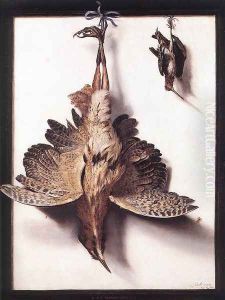Frans Cuyck Van Myerop Paintings
Frans Cuyck van Myerop was a Flemish Baroque painter known for his religious compositions, portraits, and genre scenes. Born in 1629, his early life and artistic training remain somewhat obscure, reflecting the limited historical records of many artists of his time. It is believed that he was active in Antwerp, a bustling center for the arts in the 17th century, where he would have been exposed to the works of Peter Paul Rubens and other prominent Flemish painters. These influences are evident in his mastery of the Baroque style, characterized by dramatic use of light and shadow, rich coloration, and dynamic compositions.
Cuyck van Myerop's works often depicted religious themes, a popular subject in the Counter-Reformation period, aiming to inspire devotion and convey the splendor of the Catholic Church. He was also known for his portraits, which captured the social and economic elite of his time with a keen eye for detail and psychological depth. His genre scenes, less frequently mentioned but equally significant, provide valuable insights into the everyday life and customs of 17th-century Flanders.
Despite his contributions to Flemish art, Cuyck van Myerop did not gain the same level of fame as some of his contemporaries. This may be attributed to the overshadowing presence of Rubens and Anthony van Dyck, whose works dominated the artistic landscape of the time. However, in recent years, there has been a renewed interest in his oeuvre, with art historians and collectors alike appreciating his technical skill and the emotional depth of his paintings.
Frans Cuyck van Myerop died in 1689. While specific details about his death are scant, his legacy lives on through his artworks, which continue to be studied and admired for their contribution to the Flemish Baroque tradition. As research into this period deepens, it is likely that Cuyck van Myerop's standing in the history of art will be further reevaluated and celebrated.
